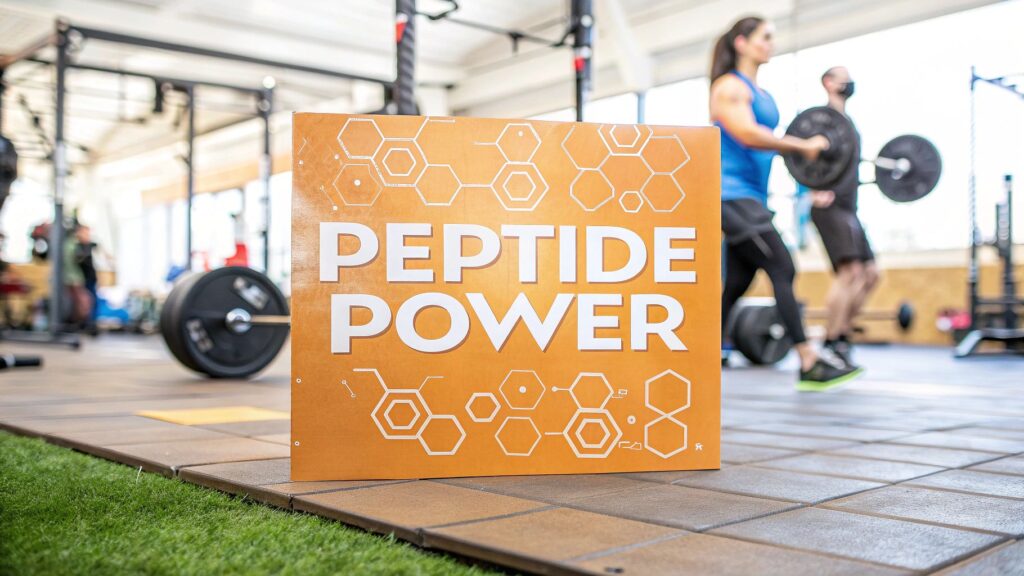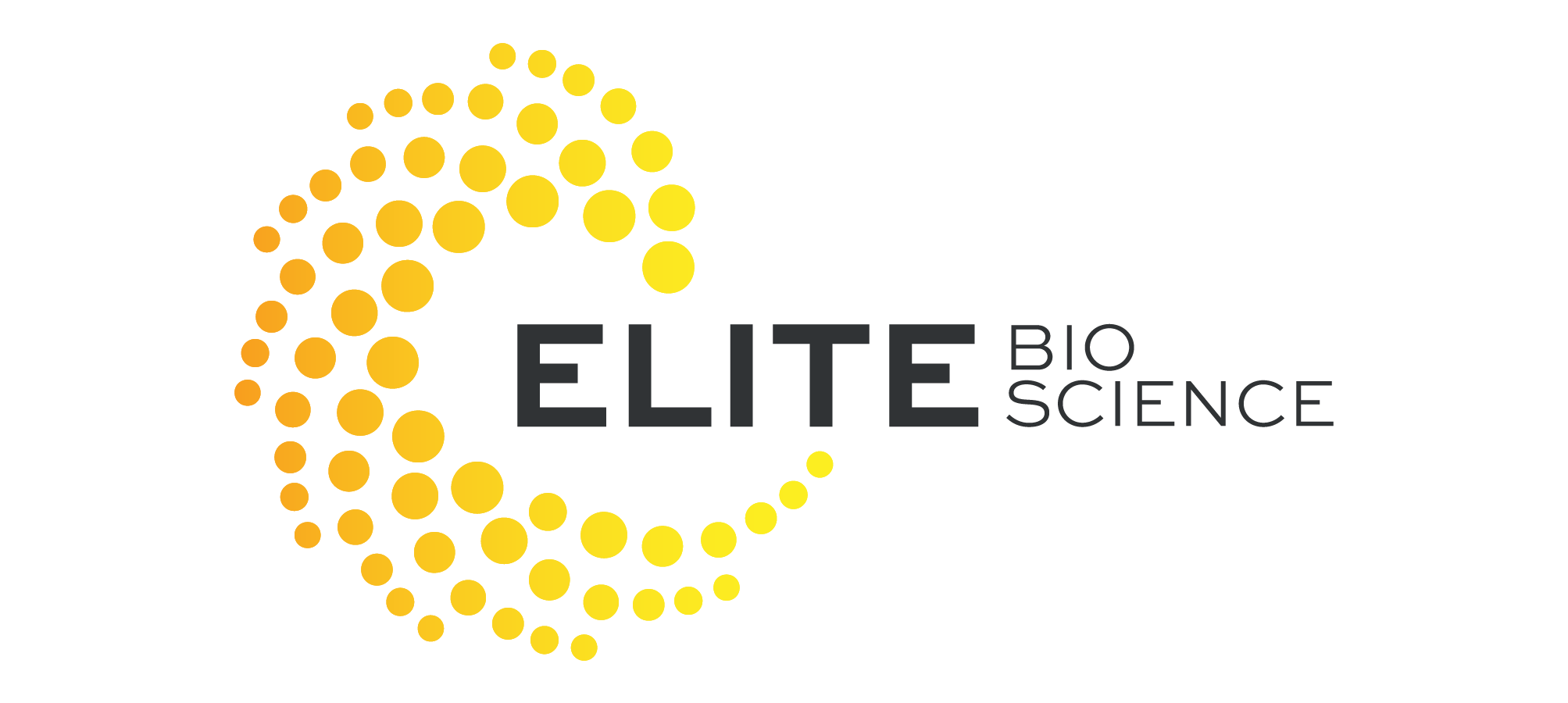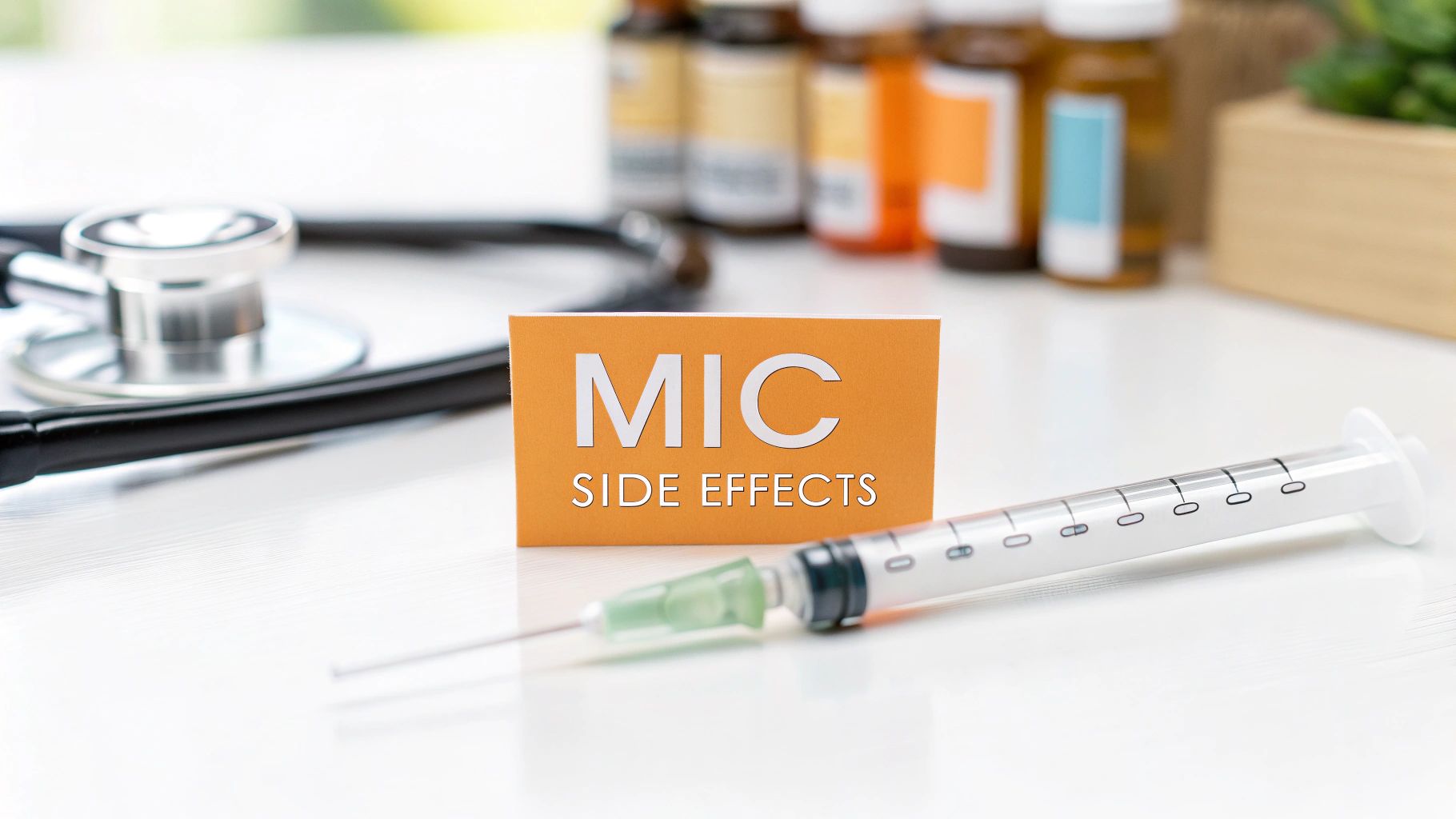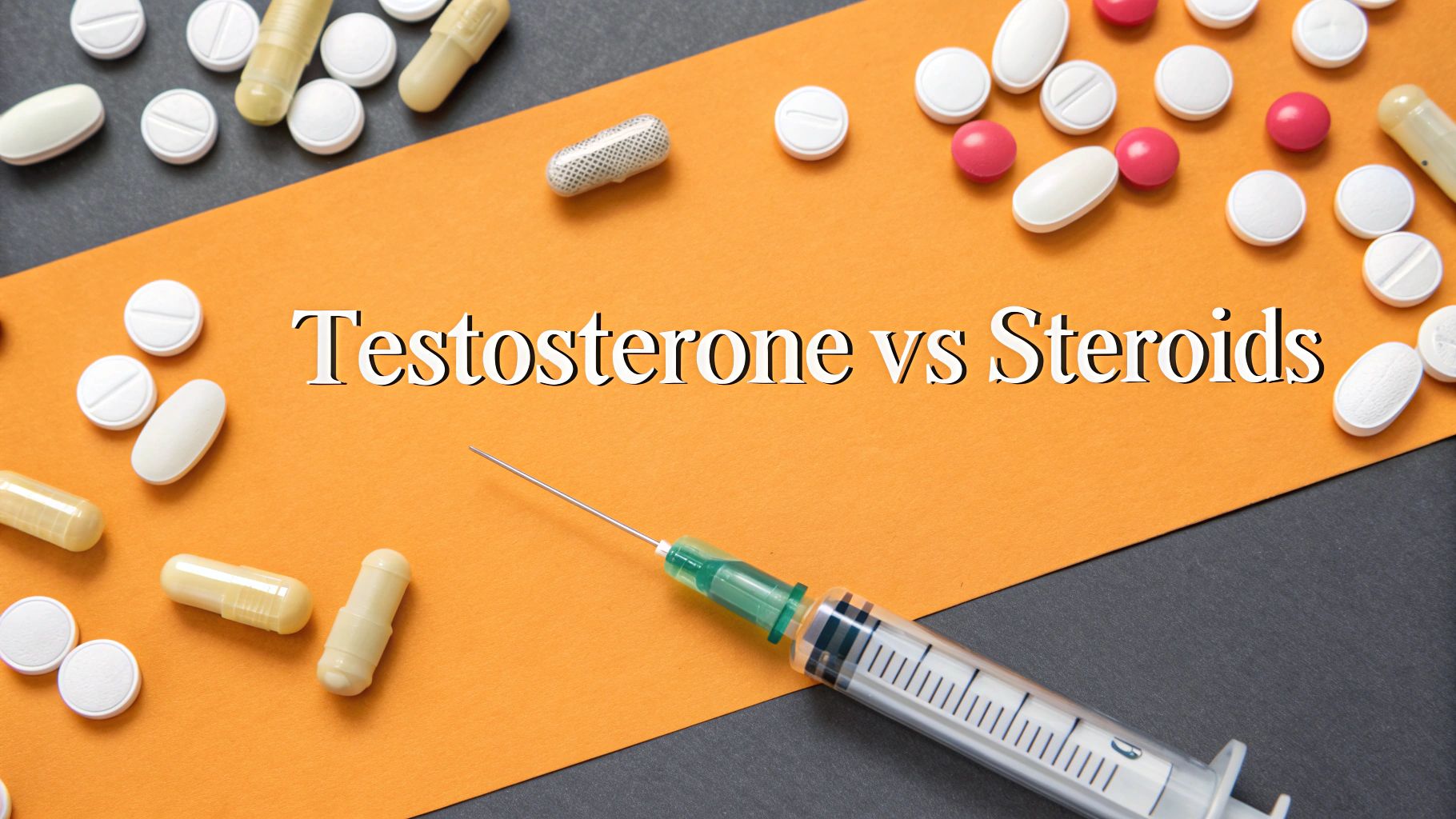What Are Peptides for Bodybuilding? Benefits & Risks Explained

In the world of fitness and bodybuilding, you’ve probably heard peptides mentioned as the next big thing. So, what are they? Think of them as tiny, highly specific messengers. They’re short chains of amino acids that deliver precise instructions to your cells, telling them to do things like accelerate muscle repair, boost growth hormone production, and speed up recovery after a brutal workout.
What Are Peptides Exactly

Let’s use an analogy. Imagine your body is a massive construction site. Amino acids are the individual bricks, and the big proteins you get from shakes and food are the completed buildings. Peptides are the foremen on the job site.
These foremen carry specific blueprints and give direct orders to the construction crew. They don’t do the heavy lifting themselves; instead, they tell your body how and when to build. One peptide might walk over to your pituitary gland and say, "Hey, we need more growth hormone over here!" while another signals muscle cells to start the repair process immediately.
This targeted signaling is what makes them so fascinating for athletes. A protein shake gives your body the raw materials, but peptides help manage the entire project, making sure those materials are used efficiently to build you back bigger and stronger.
How Peptides Differ From Proteins and Steroids
It’s easy to get peptides, proteins, and even anabolic steroids mixed up, but they operate in fundamentally different ways. Nailing down these differences is the first step for anyone seriously looking into what are peptides in bodybuilding.
Let’s clear up the confusion with a quick comparison.
Peptides vs Steroids vs Proteins At a Glance
This table breaks down the core distinctions between these three popular bodybuilding tools.
| Attribute | Peptides | Anabolic Steroids | Proteins |
|---|---|---|---|
| Primary Role | Signaling Molecules (Messengers) | Synthetic Hormones (Forcers) | Building Blocks (Materials) |
| Mechanism | Stimulate natural bodily processes | Directly mimic testosterone to force growth | Provide raw amino acids for muscle repair |
| Specificity | Highly targeted to specific cells | Broad, systemic effects | General nutritional support |
| Size | Short chains (2-50 amino acids) | Small molecules (not amino acid based) | Long chains (hundreds of amino acids) |
| Analogy | The foreman with the blueprints | The wrecking ball forcing construction | The pile of bricks and mortar |
As you can see, peptides aren't a blunt instrument like steroids, nor are they just raw fuel like protein. They are precision tools designed to optimize your body’s existing systems.
Peptides are not a replacement for hard work or proper nutrition. Instead, they are tools that can potentially optimize the body's natural response to intense physical stress, leading to better recovery and growth.
This more targeted approach is catching on in a big way. The global peptide supplements market is expected to skyrocket from USD 4.1 billion in 2025 to roughly USD 11.2 billion by 2035. That’s a massive jump, and it shows a clear shift in the fitness world toward smarter, more precise methods for achieving physique goals.
How Peptides Fuel Muscle Growth and Recovery

To really get how peptides work, think of your body as a high-performance engine. Your training and diet are the fuel, which is essential. But peptides act like the spark plugs and engine management system, making sure that fuel burns efficiently to generate maximum power.
Peptides don't build muscle directly. Instead, they optimize the natural processes your body already uses for growth and repair, essentially fine-tuning the engine for better performance.
This happens through incredibly specific cell signaling. Certain peptides, like the Growth Hormone Releasing Peptides (GHRPs), travel to the pituitary gland—your body's growth command center—and signal it to produce more of your own natural growth hormone (GH).
This is a critical distinction. Instead of injecting a synthetic hormone, these peptides simply encourage your body to ramp up its own production. The goal is to create a more anabolic, or growth-promoting, environment naturally.
Triggering Anabolic Signals
The main way peptides kickstart muscle growth is by increasing the levels of two powerful anabolic hormones: Growth Hormone (GH) and Insulin-like Growth Factor-1 (IGF-1).
Think of GH as the general manager who greenlights major construction projects in the body. IGF-1 is the on-site foreman who directly oversees muscle cell growth and repair at the ground level.
By elevating these hormones, peptides help:
- Stimulate Protein Synthesis: This is the core process where your cells build new proteins, the fundamental building blocks of muscle. More synthesis means more potential for muscle gain.
- Promote Muscle Cell Proliferation: Certain peptides can activate satellite cells—think of them as dormant muscle stem cells—which fuse with existing muscle fibers to repair damage and add size.
- Enhance Nutrient Delivery: Some peptides improve blood flow, allowing more oxygen and vital nutrients like amino acids and glucose to reach your muscles during and after a workout.
This intricate process is what makes peptide therapy for muscle growth a subject of such intense interest. It’s all about working with the body's natural machinery to get better results.
The real power of peptides lies in their ability to amplify your body’s response to training. They don’t replace hard work; they enhance the physiological rewards of the effort you put in at the gym.
Accelerating Recovery and Repair
Beyond just growth, peptides are legendary for their role in recovery. After an intense workout, your muscle fibers are riddled with microscopic tears. Peptides like BPC-157 and TB-500 act like a specialized repair crew, arriving on-site to speed up the healing of these micro-tears in muscles, tendons, and ligaments.
Faster recovery means less downtime, reduced soreness, and the ability to train harder and more frequently.
This dual-action approach—promoting growth while accelerating repair—is a major reason why the bodybuilding supplements market is seeing such a massive expansion. Projections show the market value climbing from USD 27.48 billion in 2025 to USD 47.4 billion by 2032, reflecting a clear demand for more advanced recovery and performance solutions.
Common Types of Bodybuilding Peptides
Stepping into the world of peptides can feel a bit like walking into a supplement store for the first time—there are dozens of options, and they all seem to do different things. It’s easy to get overwhelmed. But just like you wouldn’t use a pre-workout to help you sleep, you wouldn’t use a recovery peptide to pack on muscle.
Not all peptides are built for the same job. Some are designed specifically for muscle growth, others are masters of fat loss, and a special class focuses on healing up those nagging injuries. Getting a handle on these categories is the first real step to understanding how peptides fit into a serious training plan.
To cut through the noise, we can sort the most popular bodybuilding peptides by what they actually do. Think of some as the key that turns on your body’s growth hormone engine, while others act more like a specialized repair crew for tendons and ligaments.
This diagram helps visualize how different peptides fall into different functional categories.

As you can see, peptides like the GHRPs and CJC-1295 are all about signaling for more growth hormone, while something like IGF-1 LR3 is more directly involved in the muscle-building process itself.
Peptides for Muscle Growth
This is the category that gets the most attention, and for good reason. These peptides work by sending a signal to the pituitary gland, telling it to ramp up its natural production of growth hormone (GH). This, in turn, boosts levels of Insulin-like Growth Factor-1 (IGF-1), a key player in muscle hypertrophy.
- Ipamorelin: Often seen as one of the cleanest and most selective GHRPs (Growth Hormone Releasing Peptides). It delivers a strong, targeted pulse of growth hormone without messing with other hormones like cortisol or prolactin, which makes it a favorite for many.
- CJC-1295: This one is a GHRH (Growth Hormone Releasing Hormone) analog. Its job is to raise the baseline level of GH your body puts out. It’s almost always “stacked,” or used in combination, with a GHRP like Ipamorelin to create a one-two punch that maximizes GH release.
- IGF-1 LR3: This is a long-acting version of IGF-1. While the other peptides here tell the body to make more GH, IGF-1 is the hormone that directly triggers muscle growth. Using a long-acting version like LR3 is all about creating a sustained anabolic environment perfect for building new muscle.
The big idea with these growth-focused peptides isn't to introduce a synthetic hormone, but to get your body to produce more of its own natural anabolic signals. This is a crucial difference that sets them apart from traditional anabolic steroids.
To help you quickly see which peptide aligns with which goal, the table below organizes some of the most common options by their primary function.
Popular Bodybuilding Peptides and Their Primary Goals
This table categorizes common peptides by their main function to help users quickly identify options relevant to their specific bodybuilding objectives.
| Peptide Name | Primary Goal | Commonly Associated Benefit |
|---|---|---|
| Ipamorelin | Muscle Growth | Stimulates a "clean" pulse of natural growth hormone. |
| CJC-1295 | Muscle Growth | Increases baseline growth hormone levels for synergy. |
| IGF-1 LR3 | Muscle Growth | Directly promotes muscle hypertrophy (growth). |
| BPC-157 | Injury Repair | Accelerates healing of tendons, ligaments, and muscle. |
| TB-500 | Recovery | Reduces inflammation and promotes tissue regeneration. |
This breakdown makes it clear that your choice of peptide should directly reflect your most pressing fitness goal, whether that's building mass or fixing a nagging injury.
Peptides for Injury Repair and Recovery
Nothing stalls progress like a chronic injury. A persistent ache in your shoulder or knee can sideline even the most dedicated lifter, and this is where a completely different class of peptides shines. These are all about regeneration.
- BPC-157: Sometimes called the "Wolverine" peptide, BPC-157 (Body Protection Compound-157) has built a serious reputation for its system-wide healing abilities. Studies suggest it can speed up the repair of tendons, ligaments, and muscle tissue by promoting the growth of new blood vessels in damaged areas.
- TB-500: This is the synthetic version of Thymosin Beta-4, a protein your body already makes. TB-500 is a powerhouse for reducing inflammation, helping cells migrate to injury sites, and promoting tissue regeneration. It’s a go-to for athletes dealing with acute sprains or chronic pain.
These recovery peptides aren't about building new muscle from scratch. They're about maintaining the integrity of your body's structure so you can keep training hard and consistently for the long haul. Understanding these different peptide types shows that the goals are just as varied as the compounds themselves.
The Real-World Benefits for Bodybuilders
The science behind how peptides work is interesting, but what really matters is what you see in the mirror and feel in the gym. For bodybuilders, the appeal comes down to tangible results that go beyond what you can typically achieve with diet and training alone. Peptides aren't magic, but they are powerful tools for amplifying your hard work.
When used the right way, certain peptides can seriously speed up how fast you build lean muscle. By nudging your body to produce more of its own growth hormone and IGF-1, they create a much more effective anabolic state. This means the protein synthesis you trigger during a workout becomes far more efficient, leading to faster and more noticeable gains in both size and strength.
Quicker Recovery and Reduced Downtime
One of the biggest game-changers users report is dramatically better recovery. Hard training breaks down muscle fibers, and how quickly you can repair them dictates how soon you can get back to training that muscle group again. Think of peptides as a highly skilled repair crew for your body.
- Less Muscle Soreness: By calming inflammation and speeding up the healing of those micro-tears in your muscles, you'll often feel less of that crippling post-workout soreness.
- Faster Tissue Repair: Peptides are fantastic at mending not just muscle, but also those nagging connective tissues. If you're dealing with persistent tendon or ligament pain, certain peptides offer a unique restorative edge.
- Increased Training Frequency: When you recover faster, you can hit the gym harder and more often. That consistency is what leads to real, long-term progress.
For anyone focused on healing, it’s worth digging into how specific compounds get the job done. Our detailed guide on BPC-157 the ultimate recovery peptide breaks down its powerful regenerative properties.
Enhanced Fat Loss and Body Composition
Many peptides that boost growth hormone come with a very welcome side effect: they encourage your body to burn stored fat for energy, a process called lipolysis. This gives you a powerful one-two punch, allowing you to build lean muscle while simultaneously stripping away body fat.
The result is a more defined, "harder" look. It’s a huge reason why bodybuilders use peptides during cutting phases—to hold onto their hard-earned muscle while getting shredded for the stage. This isn't a niche interest, either; the peptide supplements market is projected to grow at a CAGR of about 5.5% between 2025 and 2032. You can learn more about the growth of the peptide supplement industry on Data Bridge Market Research.
Key Takeaway: The main benefits—more muscle, faster recovery, and better fat loss—all work together. Better recovery allows for more intense training, which builds more muscle. And having more muscle mass naturally revs up your metabolism, helping you burn even more fat.
Finally, many users also report valuable secondary perks like deeper, more restorative sleep and improved joint health. Quality sleep is directly tied to your body’s natural growth hormone release, creating a positive feedback loop that enhances every other aspect of your recovery and growth. All these benefits combined paint a pretty clear picture of why peptides for bodybuilding are so compelling.
Navigating the Risks and Legal Gray Areas

While the benefits sound compelling, stepping into the world of peptides requires a serious reality check. These aren't just another supplement. They’re powerful compounds that operate in a murky legal and regulatory space, and ignoring that can lead to major health consequences or even legal trouble.
The biggest red flag is that nearly every peptide sold online is slapped with the label "for research purposes only." This isn't just some quirky disclaimer; it’s a critical legal distinction. It means these products have not been approved for human consumption by agencies like the Food and Drug Administration (FDA).
This lack of approval creates a Wild West-style market. When you buy from an online source, you’re operating on blind faith, with absolutely no guarantee that the product in the vial is what it claims to be.
The Dangers of Unregulated Sources
That "research chemical" status opens the door to a whole host of dangers. With no oversight, quality control is nonexistent, leaving you wide open to issues that can directly wreck your health.
- Purity Problems: The peptide you buy could be seriously under-dosed, meaning you're not getting what you paid for. Worse, it could be contaminated with harmful bacteria, heavy metals, or other junk from sloppy manufacturing.
- Incorrect Substances: It's not unheard of for vials labeled as one peptide to contain something else entirely—often a cheaper or more dangerous compound. Without independent lab testing, you have no way of knowing what you're actually injecting.
- Inaccurate Dosing: Even if you get a pure product, the lack of medical guidance means most users are just guessing at dosages. At best, this leads to zero results. At worst, it can trigger dangerous side effects.
It's crucial to understand that buying peptides online is a gamble. You are placing your health in the hands of an anonymous, unregulated supplier who has zero accountability for the safety or efficacy of their products.
Potential Health Side Effects
Even if you manage to find a legitimate product, peptides can still cause unwanted side effects. Remember, you're intentionally manipulating your body's hormonal and signaling systems. There’s always a risk of knocking things out of balance, especially when using compounds that stimulate growth hormone.
Some of the most commonly reported side effects include:
- Water Retention and Bloating: Increased GH levels can make your body hold onto extra water, leading to a puffy look and uncomfortable, achy joints.
- Joint and Carpal Tunnel-Like Pain: This is often a direct result of that fluid retention, which can put pressure on nerves and joints, especially in the wrists and hands.
- Increased Blood Sugar Levels: Certain peptides can mess with your insulin sensitivity. For anyone predisposed to diabetes, this is a serious concern that can't be ignored.
- Unwanted Immune Responses: Injecting any foreign substance can trigger an immune reaction. This can range from minor redness and swelling at the injection site to more severe allergic reactions.
Ultimately, the allure of faster results has to be weighed against these very real and substantial risks. Before you even think about using peptides, talking to a qualified medical professional isn't just a good idea—it's absolutely essential for your safety.
Common Questions About Bodybuilding Peptides
Even after getting the basics down, it’s completely normal to have some practical questions. Let's tackle the most common ones that come up in the bodybuilding world. Think of this as the FAQ that bridges the gap between theory and real-world application, giving you a complete picture.
Are Peptides a Type of Steroid
This is probably the biggest point of confusion, and the answer is a hard no. Peptides and anabolic steroids are in completely different leagues, and mixing them up is a common but serious mistake.
Anabolic steroids are synthetic hormones—lab-made versions of testosterone. They work like a sledgehammer, directly forcing the body into an anabolic state to build muscle. Peptides, on the other hand, are much more subtle. They're signaling molecules, acting more like a skilled foreman who gently prompts your body to ramp up its own natural processes, like producing more growth hormone.
While both might lead to muscle growth, their chemical makeup, how they work, and their side effect profiles are worlds apart.
How Are Peptides Administered
For bodybuilding purposes, the go-to method is a subcutaneous injection, which just means injecting the peptide into the fatty tissue right under the skin. This route is chosen for one simple but critical reason: it works.
So, why not just pop a pill? If you were to swallow most peptides, the powerful acids and enzymes in your stomach would tear them apart into individual amino acids before they ever reached your bloodstream. They would be completely useless. Bypassing the digestive system is non-negotiable.
While some peptides might come in nasal sprays or creams, injections are widely seen as the most reliable way to get the job done in a bodybuilding context.
While we're talking about administration methods for the sake of a complete picture, it's vital to remember these are largely unregulated substances. The "how" should always be weighed against the very real risks and legal gray areas.
What Are the Risks of Buying Peptides Online
Here’s the unfiltered truth: because nearly all peptides are sold online under the "for research chemicals only" label, the market is the Wild West. It's completely unregulated. This isn’t a small detail; it's the single biggest risk you face. There is no FDA oversight, zero quality control, and absolutely no guarantee of safety.
This lack of regulation creates a minefield for anyone looking to buy:
- Contamination: The vial you receive could be tainted with bacteria, heavy metals, or other nasty stuff from a non-sterile manufacturing process.
- Incorrect Dosage: The product might be massively under-dosed (making it worthless) or over-dosed (dramatically increasing your risk of side effects).
- Wrong Substance: You could literally be sent a vial of a completely different chemical than what you ordered, which is both dangerous and a waste of money.
At the end of the day, you have no way of knowing what’s actually in the vial without paying for expensive third-party lab testing. Sourcing peptides online is a huge gamble with your health.
What Is Peptide Cycling and Stacking
In any conversation about peptides, you'll hear the words "cycling" and "stacking." These are simply strategies users follow to try and maximize the benefits while minimizing the potential downsides.
"Cycling" means using a peptide for a set period—say, 8 to 12 weeks—and then taking a break. This "off-cycle" period is meant to give your body's receptors a rest so they don't become desensitized to the peptide's signals. It also gives your system a chance to return to its normal baseline, hopefully reducing long-term side effects.
"Stacking" is just using two or more different peptides at the same time. The goal is to create synergy, where the combined effect is more powerful than what each peptide could do on its own. A classic stack is combining a GHRH (like CJC-1295) with a GHRP (like Ipamorelin) to hit growth hormone release from two different angles. These are just definitions of common practices, not endorsements.
At Elite Bioscience, we provide access to high-quality, third-party lab-tested therapies under medical guidance. To explore safe and effective options for reaching your health and performance goals, visit us at https://elitebioscience.co.
QUICK SEARCH
Make an account today to start your journey towards a better and healthier lifestyle.






